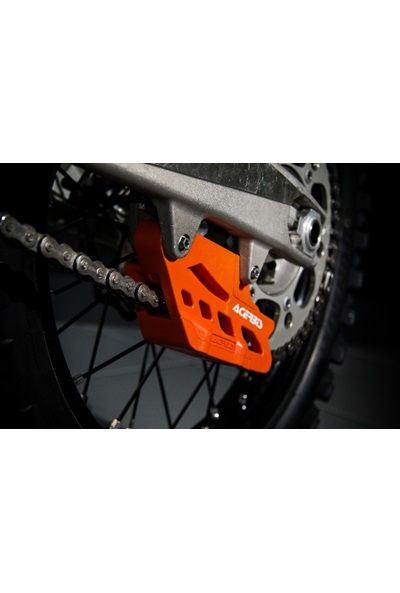What do the engine oil labels mean?
If you are not familiar with the types of engine oils for motorcycles, know that you are definitely not alone. But it is definitely something you want to know so that unsuitable or low-quality oil does not cause your machine's engine to explode. So that you no longer have to think about what the marking of which oils mean and which one to pour where, we have prepared this article for you, in which we will guide you step by step through the issue of motor oils.
.jpg)
Oil viscosity designation - SAE
This classification is the most general division. Viscosity determines how an oil behaves and flows at different temperatures. SAE (Society of Automotive Engineers) has created a system for classifying engine oil viscosity that is recognized worldwide.
According to the SAE standard, motor oils are marked XWY - for example, 10W-40, 5W-30, 0W-20. What do the letter and individual numbers mean?
The first number – X (i.e. 10, 5, 0, …) indicates the viscosity of the oil at low temperatures. The lower this number, the better the engine oil's lubricating properties at low temperatures. So the best option is the number 0.
The letter W indicates that it is a motor oil that can also be used in winter.
The second number – Y (40, 30, 20, …) indicates the viscosity at high temperatures. The higher this number, the better the engine lubricates at high temperature.
Which engine oil to choose for winter operation and which for summer?
For winter operation, it is important to choose an oil that is fluid enough at low temperatures to provide easy engine starting and immediate protection after starting. The key is the value before the letter "W" (Winter).
Recommended viscosities:
- SAE 0W-20, 0W-30, 0W-40: Oils marked "0 W" are ideal for extremely low temperatures because they remain sufficiently liquid even at very cold temperatures weather. This makes it easier to start the engine and minimizes wear and tear cold start.
- SAE 5W-20, 5W-30, 5W-40: These oils are also suitable for winter conditions and provide good starting properties. They are usually recommended for most modern engines and normal winter conditions.
- SAE 10W-30, 10W-40: Usable in slightly cold conditions, but are not so suitable for extreme cold. They are recommended where winter temperatures do not drop too low.
For summer operation, it is important that the oil provides sufficient viscosity at high temperatures, which will ensure good protection of the engine under increased load and heat.
Recommended viscosities:
- SAE 10W-40, 10W-50: These oils offer balanced properties for warm weather and provide sufficient engine protection at higher temperatures.
- SAE 15W-40, 15W-50: Suitable for older engines or at higher loads in hot conditions. They have a higher viscosity when hot, which provides stronger protection.
- SAE 20W-50: Oil with high viscosity at high temperatures, suitable for very hot conditions or for engines operating under heavy loads.
Oil performance class - API
API (American Petroleum Institute) is an organization that sets standards and specifications for motor oils and other petroleum products. API specifications are used around the world and provide information on oil performance, helping to ensure that the oil meets the minimum requirements for engine protection in various types of vehicles. They primarily focus on cars and trucks, for motorcycles and their owners this class is not so important.
European classification - ACEA
ACEA (Association des Constructeurs Européens d'Automobiles) is an organization representing European car manufacturers and setting standards for motor oils used in Europe. ACEA specifications aim to ensure the quality and performance of oils in various types of engines, including gasoline, diesel and commercial. They are particularly important in the context of European emission standards and the specific requirements of car manufacturers. Like the API specification, ACEA is not essential for motorbikes.
 PLASTICS
PLASTICS airbox and airbox covers
airbox and airbox covers NUMBER PLATE
NUMBER PLATE LOVER FORK COVERS
LOVER FORK COVERS INGNITION & CLUTCH COVER
INGNITION & CLUTCH COVER TANK COVER
TANK COVER MUD FLAP
MUD FLAP SKID PLATES
SKID PLATES FRAME PROTECTOR
FRAME PROTECTOR HEADLIGHT MASK
HEADLIGHT MASK SIDE PANELS
SIDE PANELS TAIL LIGHT FENDER
TAIL LIGHT FENDER FRONT FENDER
FRONT FENDER RADIATOR SCOOPS
RADIATOR SCOOPS REAR FENDER
REAR FENDER UNIVERSAL FENDER
UNIVERSAL FENDER BRAKES
BRAKES BRAKE DISCS & BOLTS
BRAKE DISCS & BOLTS BRAKE PADS
BRAKE PADS CALIPERS & BRAKE PUMPS
CALIPERS & BRAKE PUMPS BRAKE PEDAL
BRAKE PEDAL BRAKE HOSE
BRAKE HOSE DISC COVER
DISC COVER ENGINE PARTS
ENGINE PARTS GASKETS & SEALS
GASKETS & SEALS CYLINDER HEAD
CYLINDER HEAD CARBURETOR
CARBURETOR BEARINGS
BEARINGS FRICTION PLATES
FRICTION PLATES OIL PLUG
OIL PLUG PISTON SETS
PISTON SETS TIMING CHAINS
TIMING CHAINS CLUTCH & ACCESSORIES
CLUTCH & ACCESSORIES engine covers
engine covers FILTERS
FILTERS AIR FILTER COVER
AIR FILTER COVER OIL FILTER
OIL FILTER NET AIR FILTER
NET AIR FILTER AIR FILTER
AIR FILTER FUEL FILTER
FUEL FILTER RADIATOR
RADIATOR RADIATORS
RADIATORS RADIATOR LOUVERS
RADIATOR LOUVERS RADIATOR BRACES
RADIATOR BRACES RADIATOR HOSES
RADIATOR HOSES WHEELS
WHEELS BEARINGS
BEARINGS SPOKES
SPOKES SPACERS
SPACERS NUTS
NUTS WHEELS & RIMS
WHEELS & RIMS TPS SENSOR COVER
TPS SENSOR COVER SWINGARM & LINKAGE
SWINGARM & LINKAGE LINKAGE KIT
LINKAGE KIT KETTENBLOCK
KETTENBLOCK LINKAGE COVERS
LINKAGE COVERS SWINGARM PROTECTION
SWINGARM PROTECTION CABLES
CABLES TANKS
TANKS ADDITIONAL TANKS
ADDITIONAL TANKS TANK CAPS
TANK CAPS TANK VALVES
TANK VALVES TANK PARTS
TANK PARTS SPARK PLUG
SPARK PLUG  SHIFT LEVERS
SHIFT LEVERS STEERING
STEERING HANDLEBARS
HANDLEBARS LEVERS AND PERCH
LEVERS AND PERCH HANDGUARDS
HANDGUARDS  GRIPS
GRIPS CLAPS
CLAPS CLAMPS
CLAMPS THROTTLE TUBE
THROTTLE TUBE STEERING NECK
STEERING NECK CROSSBAR PAD
CROSSBAR PAD HANDLEBAR ACCESORIES
HANDLEBAR ACCESORIES HANDGUARD ACCESSORIES
HANDGUARD ACCESSORIES GRIP ACCESSORIES
GRIP ACCESSORIES CHAIN SET
CHAIN SET FRONT SPROCKETS
FRONT SPROCKETS SPROCKETS & SCREWS
SPROCKETS & SCREWS CHAINROLLER
CHAINROLLER SPROCKET COVERS
SPROCKET COVERS  ke kolečkům
ke kolečkům CHAIN GUIDES
CHAIN GUIDES BOLT SETS
BOLT SETS SEATS
SEATS SEAT
SEAT SEATFOAM
SEATFOAM SEAT COVER
SEAT COVER FOOTPEGS
FOOTPEGS FOOTPEGS
FOOTPEGS SPRINGS & PINS
SPRINGS & PINS PROTECTORS
PROTECTORS HEADLIGHTS
HEADLIGHTS SHOCK ABSORBERS
SHOCK ABSORBERS SIMERINGS & DUSTERS
SIMERINGS & DUSTERS SET OF BUSHINGS
SET OF BUSHINGS bleeder screw
bleeder screw sleeves for forks
sleeves for forks rear shock sleeves
rear shock sleeves REAR SHOCK ATTACHMENT
REAR SHOCK ATTACHMENT LAUNCH HELPER
LAUNCH HELPER EXHAUST
EXHAUST EXHAUST PROTECTION
EXHAUST PROTECTION COTTON WOOL
COTTON WOOL PLUGS
PLUGS HEAT-RESISTANT FOIL
HEAT-RESISTANT FOIL CONNECTING RUUBBER
CONNECTING RUUBBER SPRINGS
SPRINGS REPAIR KITS
REPAIR KITS SILENTBLOCK
SILENTBLOCK



 HELMETS
HELMETS FULL FACE
FULL FACE FLIP-UP
FLIP-UP ADVENTURE
ADVENTURE OPEN
OPEN JUNIOR
JUNIOR RETRO
RETRO women's
women's ACCESSORIES
ACCESSORIES GOGGLES
GOGGLES GLASS, TEARS OFF...
GLASS, TEARS OFF... PROTECTION
PROTECTION CHEST PROTECTORS
CHEST PROTECTORS NECK BRACES
NECK BRACES KIDNEY BELTS
KIDNEY BELTS ELBOW PROTECTORS
ELBOW PROTECTORS KNEE GUARDS
KNEE GUARDS BACKBONE
BACKBONE BODY ARMOUR
BODY ARMOUR JUNIOR
JUNIOR BOOTS
BOOTS travel
travel ANKLE
ANKLE ENDURO
ENDURO JUNIOR
JUNIOR soles and more
soles and more Boots
Boots on a scooter
on a scooter JERSEYS
JERSEYS JUNIOR
JUNIOR JACKETS
JACKETS ENDURO
ENDURO women
women REFLECTIVE
REFLECTIVE PANTS
PANTS ENDURO
ENDURO TEXTILIE
TEXTILIE  jeans
jeans summer
summer Sweatpants
Sweatpants GLOVES
GLOVES WINTER
WINTER ENDURO
ENDURO summer
summer WATERPROOF
WATERPROOF T-SHIRTS
T-SHIRTS trika-uni
trika-uni Children's T-shirts
Children's T-shirts Mini T-shirts
Mini T-shirts SOCKS
SOCKS WATERPOOF GEAR
WATERPOOF GEAR Headwear
Headwear HAT
HAT SWEATSHIRT
SWEATSHIRT shorts
shorts friee time
friee time SOFT PANTS
SOFT PANTS VESTS
VESTS Accessories for bikers
Accessories for bikers HOODS
HOODS SCARF
SCARF belts
belts drobnosti
drobnosti THERMO UNDERWEAR
THERMO UNDERWEAR THERMO T-SHIRTS
THERMO T-SHIRTS THERMO PANTS
THERMO PANTS THERMO KNEE SOCKS
THERMO KNEE SOCKS MEFO MOUSSE
MEFO MOUSSE MOUSSE GEL
MOUSSE GEL MOUSSE KIT
MOUSSE KIT 10"
10" 12"
12" 14"
14" 16"
16" 17"
17" 18"
18" 19"
19" 20"
20" 21"
21" TUBE
TUBE 4"
4" 5"
5" 6"
6" 8"
8" 9"
9" 10"
10" 12"
12" 13"
13" 14"
14" 15"
15" 16"
16" 17"
17" 18"
18" 19"
19" 21"
21" 22"
22" 23"
23" HALTERS
HALTERS MX TIRE
MX TIRE 10"
10" 12"
12" 14"
14" 15"
15" 16"
16" 17"
17" 18"
18" 19"
19" 20"
20" 21"
21" ENDURO TIRE
ENDURO TIRE ROAD TIRE
ROAD TIRE 15"
15" 23"
23" 4"-6,5"
4"-6,5" 8"
8" 13"
13" TOOLS
TOOLS Wrenches, hooks, screwdrivers
Wrenches, hooks, screwdrivers TIRE LEVERS
TIRE LEVERS  CHAIN BREAKERS
CHAIN BREAKERS Preparations for shocks
Preparations for shocks Preparations for wheels
Preparations for wheels Engine preparations
Engine preparations Preparations for bearings
Preparations for bearings OTHER MOTO TOOLS
OTHER MOTO TOOLS GRAPHICKITS, NUMBERS
GRAPHICKITS, NUMBERS Canisters, measuring cups
Canisters, measuring cups TRANSPORT
TRANSPORT CARPETS
CARPETS MOTORCYCLE COVERS
MOTORCYCLE COVERS HOURMETER
HOURMETER helpers for track and training
helpers for track and training STAND
STAND HYDRATION BAGS
HYDRATION BAGS PIT BOARD, MARKER
PIT BOARD, MARKER MOTO LUGGAGE
MOTO LUGGAGE BACKPACKS
BACKPACKS WAIST PACKS
WAIST PACKS FORK OIL
FORK OIL AIR FILTER OIL
AIR FILTER OIL CHAIN LUBES
CHAIN LUBES COOLANT FLUID
COOLANT FLUID BRAKE FLUID
BRAKE FLUID CLEANER AND IMPREGNATION
CLEANER AND IMPREGNATION additives
additives VOUCHERS
VOUCHERS KEYCHAINS
KEYCHAINS WRISTBANDS
WRISTBANDS STAND
STAND PLATE
PLATE BOOK
BOOK WEAR SALE
WEAR SALE HELMETS SALE
HELMETS SALE LEVERS SALE
LEVERS SALE MTB JERSEY
MTB JERSEY MTB PANTS
MTB PANTS bike bags
bike bags cyclo kidney
cyclo kidney MTB HANDGUARDS
MTB HANDGUARDS MTB ACCESSORIES
MTB ACCESSORIES Jiří Fulín
Jiří Fulín



.jpg)








